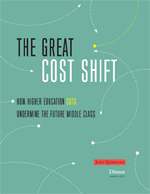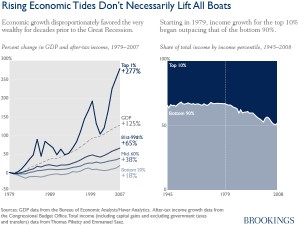Policy Points
04.04.2012
News Releases, Our Projects, Policy Points
 Completed in early 2012 for Demos, a public policy organization in New York City, The Great Cost Shift: How Higher Education Cuts Undermine The Future Middle Class, examines how state disinvestment in public higher education over the past two decades has shifted costs to students and their families. Such disinvestment has occurred alongside rapidly rising enrollments and demographic shifts that are yielding more economically, racially, and ethnically diverse student bodies. As a result students and their families now pay—or borrow—a lot more for a college degree or are getting priced out of an education that has become a requirement for getting a decent job and entering the middle class.
Completed in early 2012 for Demos, a public policy organization in New York City, The Great Cost Shift: How Higher Education Cuts Undermine The Future Middle Class, examines how state disinvestment in public higher education over the past two decades has shifted costs to students and their families. Such disinvestment has occurred alongside rapidly rising enrollments and demographic shifts that are yielding more economically, racially, and ethnically diverse student bodies. As a result students and their families now pay—or borrow—a lot more for a college degree or are getting priced out of an education that has become a requirement for getting a decent job and entering the middle class.
The study traces trends in the size and composition of the young adult population and analyzes patterns in state support for public higher education over the past two decades. Trends in tuition and financial aid are also examined and policy recommendations are presented for ways to renew America’s commitment to nurturing a strong and inclusive middle class through investments in public higher education.
04.04.2012
In the News, Policy Points
Over the winter, South by North Strategies, Ltd. conducted research into changes in state support in public higher education from 1990 onward for Demos, a national public policy organization based in New York City.
The forthcoming report, entitled The Great Cost Shift in Higher Education, will be the subject of a forum to be held at North Carolina Central University in Durham at 7:30 p.m. on April 4, 2012. The event, which will feature South by North Strategies’ research, is being sponsored by Demos, the NC Justice Center, the Campaign for Young America, and NC Central University.
Click here to register for the event, which will take place in the Alfonso Elder Student Union on the campus of NC Central University (campus map).
03.04.2012
Policy Points
Economic policy reports, blog postings, and media stories of interest:
03.04.2012
Policy Points
The Brookings Institution graphs changes in the share of total income received by those in the bottom 10 percent of the income distribution compared to those in the top 10 percent from 1945 to 2008. Since 1975, the gap between the two groups has widened considerably.

03.04.2012
Policy Points
From the Center for American Progress’ “Economic Snapshot” for March 2012 …
Labor market pressures fall especially on communities of color, young workers, and those with less education.The African American unemployment rate in February 2012 stayed well above average at 14.1 percent, and the Hispanic unemployment rate stayed high at 10.7 percent, while the white unemployment rate was 7.3 percent. Youth unemployment stood at a high 23.8 percent. And the unemployment rate for people without a high school diploma stayed high at 12.9 percent, compared to 8.3 percent for those with a high school diploma and 4.2 percent for those with a college degree. Vulnerable groups have struggled disproportionately more amid the weak labor market than white workers, older workers, and workers with more education. But even those groups that fare better than their counterparts in the weak labor market suffer tremendously from high and long-term unemployment.
 Completed in early 2012 for Demos, a public policy organization in New York City, The Great Cost Shift: How Higher Education Cuts Undermine The Future Middle Class, examines how state disinvestment in public higher education over the past two decades has shifted costs to students and their families. Such disinvestment has occurred alongside rapidly rising enrollments and demographic shifts that are yielding more economically, racially, and ethnically diverse student bodies. As a result students and their families now pay—or borrow—a lot more for a college degree or are getting priced out of an education that has become a requirement for getting a decent job and entering the middle class.
Completed in early 2012 for Demos, a public policy organization in New York City, The Great Cost Shift: How Higher Education Cuts Undermine The Future Middle Class, examines how state disinvestment in public higher education over the past two decades has shifted costs to students and their families. Such disinvestment has occurred alongside rapidly rising enrollments and demographic shifts that are yielding more economically, racially, and ethnically diverse student bodies. As a result students and their families now pay—or borrow—a lot more for a college degree or are getting priced out of an education that has become a requirement for getting a decent job and entering the middle class.

 Email Sign-Up
Email Sign-Up RSS Feed
RSS Feed